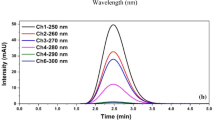Summary
Compounds without own detector response can be detected and quantified by a UV-absorbing or fluorescent, ion-pairing probe in reversed-phase liquid-solid systems. Charged as well as uncharged samples give response by affecting the distribution of the probe between the phases. The probe is usually a hydrophobic organic ion. It is included in the mobile phase, which also contains a counter ion and an ion of the same charge as the probe, both fairly hydrophilic. The choice of properties and concentrations of the hydrophilic ions is essential for the response since too low and too high distribution of the mobile phase ions to the adsorbent will make the system insensitive. It is with UV-absorbing probes possible to get a response corresponding to a molar absorptivity of more than 3000 for ionic samples. Fluorescent probes have given 3–5 times higher sensitivity. Uncharged compounds give as a rule lower response. A combination of two UV-absorbing probes with different charge gives a considerable improvement of the response for samples with low retention. A simplified theoretical model for the detector response is suggested on the basis of detailed studies of the concentration changes in the eluted mobile phase.
Similar content being viewed by others
References
S. Eksborg, B. A. Persson, Acta Pharm Suecia8, 205 (1971).
S. Eksborg, Acta Pharm. Suecia12, 19 (1975).
W. Santi, J. M. Huen, R. W. Frei, J. Chromatogr.115, 423 (1975).
J. Crommen, B. Fransson, G. Schill, J. Chromatogr.142, 283 (1977).
J. Crommen, J. Chromatogr.193, 225 (1980).
L. Hackzell, G. Schill, Acta Pharm. Suecia18, 257 (1981).
M. Denkert, L. Hackzell, G. Schill, Acta Pharm. Suecia18, 271 (1981).
M. Denkert, L. Hackzell, G. Schill, E. Sjögren, J. Chromatogr.218, 31 (1981).
N. A. Parris, Anal. Biochem.100, 260 (1979).
N. A. Parris, J. Liq. Chromatogr.3, 1743 (1980).
B. A. Bidlingmeyer, J. Chromatogr. Sci.18(10), 525 (1980).
S. Y. Su, A. Jurgensen, D. Bolton, J. D. Winefordner, Anal. Letters.14(A1), 1 (1981).
T. Gnanasambandan, H. Freiser, Anal. Chem.53, 909 (1981).
K. Slais, M. Krejci, J. Chromatogr.91, 161 (1974).
R. M. McCormick, B. L. Karger, J. Chromatogr.199, 259 (1980).
A. Tilly Melin, Y. Askemark, K. G. Wahlund, G. Schill, Anal. Chem.51, 976 (1979).
A. Tilly Melin, M. Ljungcrantz, G. Schill, J. Chromatogr.185, 225 (1979).
A. Sokolowski, K. G. Wahlund, J. Chromatogr.189, 299 (1980).
I. M. Johansson, J. Liq. Chromatogr.4, 1435 (1981).
Author information
Authors and Affiliations
Rights and permissions
About this article
Cite this article
Hackzell, L., Schill, G. Detection by ion-pairing probes in reversed-phase liquid chromatography. Chromatographia 15, 437–444 (1982). https://doi.org/10.1007/BF02261604
Received:
Accepted:
Issue Date:
DOI: https://doi.org/10.1007/BF02261604




